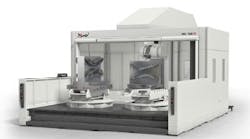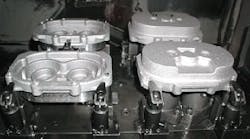By Hank Limper and Ken Cavanaugh
Houghton International Inc.
Edited By Jim Benes, Associate Editor
The two main functions of metalworking coolants are to cool the tool and reduce friction in the cut.
Also important, are clearing of chips, inhibiting corrosion, providing biostability and providing an operator-friendly environment. Coolants are complex chemical formulations created to meet these performance requirements.
Shops usually run many different machining operations, each with its specific coolant requirements. To meet these needs, coolant formulators have created hundreds of products with differing capabilities.
In the past, it was not uncommon for shops to have a dozen coolants onsite to match an engineer’s idea of the most favorable coolant for each machine. However, different coolants on the machining floor led to issues with crosscontamination and waste stream inconsistencies. Additionally, multiple coolants caused inventory nightmares.
Now, shops have moved toward finding one or a limited number of coolants for all processes in the shop.
This has led coolant suppliers to develop more sophisticated products that help to manufacture superior parts while addressing the challenges of cooling, lubrication, corrosion resistance, and microbial control. With so many processes and varieties of coolants on the market, shops are faced with a complicated challenge in choosing the best performing, most economical fluids for their operations.
Also, there is always room for differences of opinion as to the best coolant for any specific process. A basic understanding of how the various components of the three primary coolant classifications — straight oils, soluble oils and synthetics — affect performance can simplify the task.
Straight oils Water insoluble straight oils are derived from a petroleum (mineral oils), animal or vegetable origin and are used “straight,” without dilution with water.
These oils provide good lubricity and rust prevention, extended sump life and are easy to maintain. Also, they do not sour, as bacteria will normally only survive in fluids containing water.
Straight oils may be a blend of one or more of the various base oils and may also contain boundary and/or extreme-pressure additives such as sulfur, phosphorous or chlorine compounds. Straight oils reduce the forces generated as a tool cuts metal so the tool cuts cleanly to produce a smooth surface finish on the workpiece.
Additives can increase a straight oil’s lubricity to enhance the cushion between the metal being cut and the cutting tool. For extreme machining, additives may exceed 20 percent of the product makeup.
Although they are more expensive than their non-fortified counterparts, straight oils combined with additives are essential in processes where surface finish and tool life are critical, such as crush grinding, severe broaching and tapping, and deep-hole drilling. In addition, straight oils guard against microscopic welding in heavy-duty machining, and additives may enhance the anti-welding properties of the metal.
On the other hand, straight oils are not flame retardant and can give off smoke that creates an unfriendly machining environment for operators. Straight oils also may leave an objectionable film on almost every surface in the plant.
Soluble oils
Soluble oils are suitable for light to heavy-duty machining operations, including ferrous and nonferrous applications.
Wetting agents and extreme-pressure additives can expand their range to include the more heavy-duty processes usually handled by straight oils.
Soluble oils usually are classified either as semi-synthetics or as true soluble oils that differ primarily in the amount of oil used in the concentrate.
Soluble oils contain 40 percent or more oil in the concentrates that suppliers sell and are mixed with water to create the metalworking fluid. These fluids provide good cooling — water has a high heat capacity and readily dissipates heat — and lubrication capabilities that results from the blend of oil and water. They also usually leave a protective coating on moving parts of machine tools.
Although soluble oils make for quality lubricants that promote long-lasting tool life, they don’t always offer the same level of lubricity as straight oils.
They also require more maintenance than straight oils. The use of water makes soluble oils more prone to bacterial growth and rancidity, so a shop should follow a strict preventive maintenance program to extend sump life.
Operators need to keep a close eye on the type of water they are combining with soluble oils.
If mixed with hard water, soluble oils tend to form precipitates on workpieces and machines. Well water might be hard and may also contain chloride ions or sulfates that promote corrosion.
Shops should use premium coolants that offer adequate corrosion inhibition, or they may need to add sumpside corrosion inhibitors to the coolant. On the other hand, machine shops using soft water with soluble oil-based coolants may tend to generate foam that requires sumpside additives such as defoamers.
Semi-synthetic coolants
Semi-synthetic coolants are formulated with up to 40 percent petroleum oil in a water-dilutable concentrate. Emulsifiers, wetting agents, corrosion inhibitors, extreme-pressure components and biocides can also be added.
These coolants normally are translucent, but can vary from being transparent to completely opaque.
Semi-synthetics can be used in a wide range of tooling applications, and they provide good lubrication for moderate to heavy-duty operations. They allow operators to cut at higher speeds and feedrates because they typically have better cooling and wetting properties than soluble oils.
Formulated with less oil, semi-synthetics sometimes have better settling and cleaning properties. They tend to generate less smoke as they are comprised of less oil than straight or soluble oils.
The disadvantages of semi-synthetics are similar to those associated with soluble oils — water hardness affects their stability. Using hard water with semisynthetics can cause the formation of hard water deposits in the sump, and they might foam with soft water.
Synthetic coolants
Synthetic coolants do not contain petroleum-based oil.
Usually, they consist of lubricants and rust inhibitors dissolved in water. Suppliers provide synthetics as concentrates, much like soluble oils, and they are mixed with water to create the coolant.
Synthetics are characterized by high cooling capacities because of their additives and the water added to the concentrate, and they are preferred for highheat and high-velocity metalworking, such as surface grinding. Additives can have a profound effect on lubricity and, when added to some synthetics, give them better lubricating characteristics than straight oils without additives.
Heavy-duty synthetics have been developed over the past few years that now can handle most machining processes.
Synthetic coolants consist of several classes based on their composition:
Simple fluids are used for lightduty grinding operations. They create transparent solutions when mixed in a sump, so operators can see the metal being worked.
Complex fluids contain synthetic lubricants and are used for moderate to heavy-duty machining that can be performed at high speeds. They also form a transparent solution in sumps.
Emulsifiable fluids contain chemicals to create specific lubricant characteristics, and their appearance is similar to soluble oils.
Synthetics tend to be resistant to rancidity and typically offer good microbial control. Most are formulated to provide protection against corrosion and demonstrate impressive cooling ability.
Historically, many disadvantages have been associated with synthetics. Synthetics are often more expensive than their oil counterparts. Also, some synthetics run almost too clean.
That is, their detergent-like nature causes some synthetics to dry out machine tool seals, as well as operators’ skin and mucous membranes. Sticky, tacky residues have long been associated with many synthetic coolants.
Some believe that synthetics are less prone to misting, but that is not necessarily true. Depending on their make-up and the operation, they might not be creating a visible oil mist like a soluble, but they still can mist and contribute to mucous membrane irritation in the nose, throat and eyes. Because they don’t contain oils, synthetics tend to be more aggressive toward human skin.
| Tips on choosing the right coolant The best coolant will protect the machine and extend the life of the tools while providing an environment that is acceptable to operators and the environmental health and safety department. Choosing the best coolant to optimize all those parameters is best made with input from both the machine tool manufacturer and the coolant supplier. Shop operators and engineers often rely on the expertise of coolant suppliers to discuss and recommend the best coolant for the material being machined. Most shops want to minimize the number of different coolants used, if possible, to reduce the cost of coolant maintenance and disposal and to allow them to buy coolant in bulk for extra savings. Some machine tool builders demand a specific coolant for their product. A number of builders have a recommended list of coolants that must be used to validate the machine’s warranty. When a shop is considering buying machine tools, it should go to the machine builder and indicate the coolants that currently are used in the shop. Then, the builder and coolant supplier can work together to determine how the current coolants will work in any new machine. |








